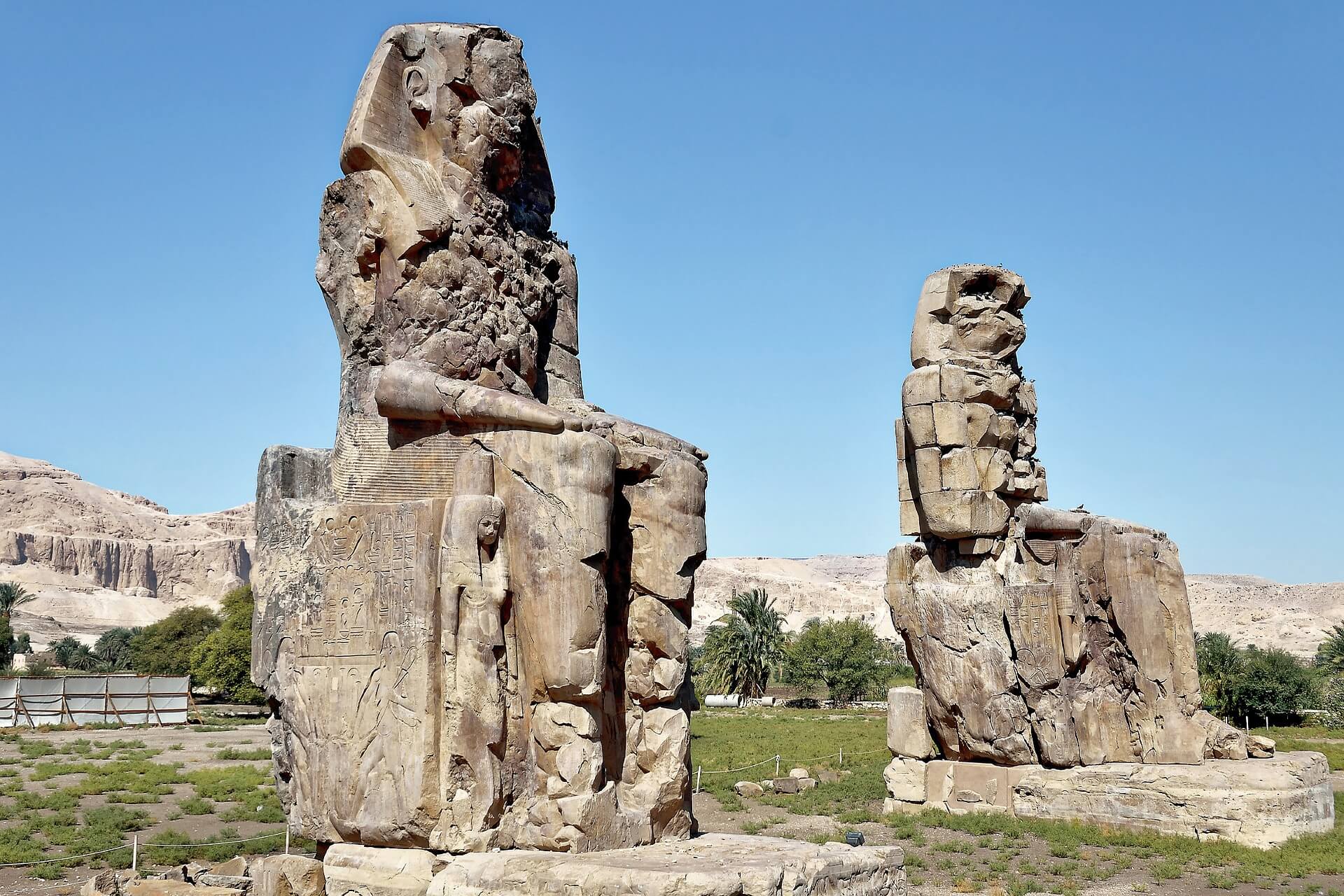Cities, will have signs of artistic expression on buildings or walls in the form of graffiti and the Colossi of Memnon were no exception. They sometimes come into view as the beautification of an ugly structure, a call to attention, or a vandalization, all at the same time depending on who you may ask.
It goes to show how different perspectives can shape ideas, and one ponders how all this will be seen from future vantage points. A scribble on the wall 2000 years from now can be a treasure trove.
Colossal statues of Colossi of Memnon
Ancient Egyptian structures that were graffitied over by ancient tourists. Though graffiti is not a word that accurately described it. In Luxor, known in the past as Thebes, lie many ruined structures of the past.
One such structure can be found on the west bank of the River Nile, close to the modern-day city of Luxor. It’s Amenhotep III’s mortuary complex and temple nad it’s avery popular attraction.
Twin statues loom in front of the now ruined complex, facing the Nile River. It holds a constant gaze upon the life-giving waters. They stand as guardians of the mortuary complex and depict the Pharaoh himself settled on the throne. It’s embellished with images of his mother, his wife, and the Nile River God, Hapi.
As the most preserved remaining constructions and the sheer size of them, 18 meters in height, they command admiration. These two sculptures are widely known as the Colossi of Memnon.
What’s in a name
The name itself comes from how Ancient Greeks saw the statues. As is in human nature, we associate many things to what is familiar, like seeing faces in inanimate objects. The Greeks visiting the resting place of Amenhotep III, associated the two remaining statues with the Greek mythological hero, Memnon.
He was king Of Ethiopia and fought on the side of the Trojans defending their city. He was slain by Achilles. Memnon’s bravery and fearlessness in battle made him a hero in the Ancient Greek’s eyes. Even though he fought on the opposite side.
Amenhotep III
Tthe complex, and the two colossal statues, were built during the reign of Amenhotep III Pharaoh. This was in the 14th century BCE. The statues were carved out of blocks of quartzite sandstone. The stone came from either El-Gabal el-Ahmar near Cairo in the north, or from Gebel el-Silsileh near Aswan.
There was a gate between the two Colossi, but time and Niolle floods eroded it and everything behind it. It must have been a sight all those engravings and colors decorating the entire structure. It gave it a regal air as it deserved. People navigating the river or walking by it would be dwarfed by the size and opulence.
Earthquakes effects on Colossi of Memnon
Earthquakes also came into play to further damage it. The Armenian Institute of Seismology reported an earthquake dated around 1200 BCE. This destroyed the temple, leaving only the two enormous statues that still stand guard.
Many other statues were buried in pristine conditions, by the many chasms that were open in the quake. Later on, many of those statues were found, excavated, and placed on display in the Luxor Museum.
From stone faces to oracle
In 27 BCE another Earthquake shook the two Colossi, this one reported by the Ancient Roman geographer Strabo. This eneded in the collapse of the upper half of the northern colossus. After this, people started hearing sounds coming from the broken statue.
The singing statues
Many reported that it sang, or made lyre sounds or even whistled. This always happened at dawn, when the sun rose. About this time is when the Greek tourists coming to hear the signing statues named it after one of their own mythical heroes.
It also did not help that Memnon was supposedly the son of the goddess of dawn, Eos, and the statue only sang at dawn.
The Colossus began appearing more like an oracle to people flocking around it. Many asked questions and hoped to hear a sound, thus attributing it with good fortune.
Some of them carved their experiences in the stone statues themselves, marking them with Ancient graffiti, still visible today. Although we doing this in modern time would provoke outrage at vandalizing these priceless artifacts, the Ancient attribute of these scribbles assigns them historic value.
The popularity of this destination in Ancient Rome brought even the Emperor Septimus Severus on a visit in circa 199 CE. Upon not hearing the statue sign, he had it reconstructed by adding a number of sandstone blocks on top in an attempt to garner favor with the gods. It was never heard singing again from that point on. The original top half of the Colossus was never found.
Today it is still a popular tourist attraction of Egypt’s Luxor. The two remaining Colossi, surviving for millennia on the banks of the world’s greatest river, still sing in a way. They sing to the tune of history and still stand guard, facing the mighty river in a constant vigil with the mountains at their back.



Leave a Comment